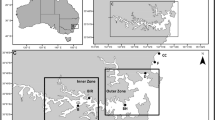Abstract
An experimental study was conducted in a South Carolina, USA salt marsh to examine relationships between meiofaunal-sized tube structure and densities of burrowing meiofauna. Abundance of the tube-building polychaete Manayunkia aestuarina Bourne was increased by erecting exciosure areas from June–August 1979. Non-manipulated areas of identical dimensions were staked out in adjacent locales. Densities of burrowing meiofauna and nematode trophic groups, and volumes of Spartina alterniflora root mat and tube-builders were monitored approximately every 2 wk from each experimental treatment. Volumes of tube-builders were significantly higher inside exclosure sites on all dates in July and August. Root-mat volume and total number of nematodes were not different between treatments at any time. The dominant copepod species, Stenhelia (D.) bifidia, and the nematode species, Spirinia sp., first increased in number inside manipulated sites and then decreased in abundance as tube volume increased. No general trend was apparent for nematode trophic groups when areas with increased volumes of tubebuilders were compared to unmanipulated sites. The fact that densities of S (D.) bifidia and Spirina sp. decreased only when tube-builders attained highest abundance suggests that negative interactions between tube-builders and these meiofaunal taxa may be effective only at elevated abundances.
Similar content being viewed by others
Literature cited
Aller, R. C.: The effects of macrobenthos on chemical properties of marine sediment and overlying water. In: Animal-sediment relation, pp 53–102. Ed. by P. L. McCall. New York: Plenum Press 1982
Aller, R. C. and J. Y. Yingst: Biogeochemistry of tube-dwellings: a study of the sedentary polychaete Amphitrite ornata (Leidy). J. mar. Res. 36, 201–254 (1978)
Bell, S. S.: Short- and long-term variation in a high marsh meiofauna community. Estuar. coast. mar. Sci 9, 331–350 (1979)
Bell, S. S.: Meiofauna-macrofauna interactions in a high salt marsh habitat. Ecol. Monogr. 50, 487–505 (1980)
Bell, S. S.: On the population biology and meiofaunal characteristics of Manayunkia aestuarina (Polychaeta: Sabellidae: Fabricinae) from a South Carolina salt marsh. Estuar. Coast. Shelf Sci. 14, 215–221 (1982)
Bell, S. S. and B. C. Coull: Field evidence that shrimp predation regulates meiofauna. Oecologia (Berl.) 35, 141–148 (1978)
Bell, S. S. and B. C. Coull: Experimental evidence for a model of juvenile macrofauna-meiofauna interactions, In: Marine benthic dynamics, pp 179–192. Ed. by K. R. Tenore and B. C. Coull. Columbia: Univ. of South Carolina Press 1979
Bell, S. S., M. C. Watzin and B. C. Coull: Biogenic structure and its effect on the spatial heterogeneity of meiofauna in a salt marsh. J. exp. mar. Biol. Ecol. 35, 99–107 (1978)
Blundon, J. A. and V. S. Kennedy: Refuges for infaunal bivalves from blue crab, Callinectes sapidus (Rathbun) predation in Chesapeake Bay. J. exp. mar. Biol. Ecol. 65, 67–81 (1982)
Brenchley, G. A.: Mechanisms of spatial competition in marine soft-bottom communities. J. exp. mar. Biol. Ecol. 60, 17–33 (1982)
Eckman, J. E., A. R. M. Nowell, and P. A. Jumars: Sediment destabilization by animal tubes. J. mar. Res. 39, 361–374 (1981)
Orth, R. J.: The importance of sediment stability in seagrass communities, In: Ecology of marine benthos, pp 281–300. Ed. by B. C. Coull. Columbia: Univ. of South Carolina Press 1977
Peterson, C. H.: Clam predation by whelks (Busycon spp.): experimental tests of the importance of prey size, prey density, and seagrass cover. Mar. Biol. 66, 159–170 (1982)
Pitcher, R. S.: Factors influencing the movement of nematodes in soil, In: Nematode vectors of plant viruses, pp 389–407. Ed. by F. Lambert, C. E. Taylor and J. W. Seinhorst. New York: NATO Advanced Study Institute Series, Series A, Life sciences, vol. 2 1975
Reise, K.: Predator exclusion experiments in an intertidal mud flat. Helgol. wiss. Meeresunters. 30, 263–271 (1977)
Reise, K.: Experiments on epibenthic predation in the Wadden Sea. Helgol. wiss. Meeresunters. 31, 55–101 (1978)
Reise, K.: High abundances of small zoobenthos around biogenic structure in tidal sediments of the Wadden sea. Helgol. wiss. Meeresunters. 34, 413–425 (1981a)
Reise, K.: Gnathostomulida abundant alongside polychaete burrows. Mar. Ecol. Prog. Ser. 6, 329–333 (1981b)
Ringold, P.: Burrowing, root mat density, and the distribution of fiddler crabs in the eastern United States. J. exp. mar. Biol. Ecol. 36, 11–21 (1979)
Teal, J. M. and W. Wieser: The distribution and ecology of nematodes in a Georgia salt marsh. Limnol. Oceanogr. 11, 217–222 (1966)
Virnstein, R. J.: The importance of predation by crabs and fishes on benthic infauna in Chesapeake Bay. Ecology 58, 1199–1201 (1977)
Warwick, R. M. and R. Price: Ecological and metabolic studies on free-living nematodes from an estuarine mud-flat. Estuar. coast. mar. Sci. 9, 257–271 (1979)
Wieser, W.: Die Beiehung zwischen Mundhöhlengestalt, Ernährungseise und Vorkommen bei freilebenden marinen Nematoden. Eine ökologisch-morphologische Studie. Ark. Zool. Ser. II 4, 439–484 (1953)
Wieser, W. and J. W. Kanwisher: Ecological and physiological studies on marine nematodes from a small salt marsh near Woods Hole, Massachusetts. Limnol. Oceanogr. 6, 262–270 (1961)
Woodin, S. A.: Adult-larval interactions in dense infaunal assemblages: patterns of abundance. J. mar. Res. 34, 25–41 (1976)
Author information
Authors and Affiliations
Additional information
Communicated by S. K. Pierce, College Park
Rights and permissions
About this article
Cite this article
Bell, S.S. An experimental study of the relationship between below-ground structure and meiofaunal taxa. Marine Biology 76, 33–39 (1983). https://doi.org/10.1007/BF00393052
Accepted:
Issue Date:
DOI: https://doi.org/10.1007/BF00393052




